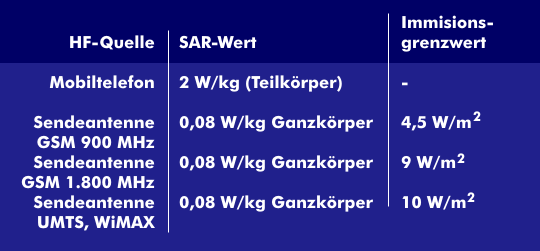specific absorption rate (SAR)
The Specific Absorption Rate(SAR) is a radiation value that indicates how much electromagnetic radiation a person can absorb without posing a health risk. The specific absorption rate plays a role in the use of radios and cell phones as well as in the operation of base stations and relates to the human body, in particular to the head and eyes.
The SAR value is a measure of the thermal heat absorbed by the body when using a cell phone or in the vicinity of a base station. It is measured using a SAR measurement method standardized by the Comité Européen de Normalisation Electrotechnique( CENELEC) and described in EN standard 50361. In this process, a head made of plastic is simulated and filled with a liquid that corresponds in behavior to human tissue. Measuring probes are then used to determine the radiation at various points inside the plastic head.
The general SAR value is a value averaged over the human body weight, expressed in absorbed power in relation to body weight (W/kg). The limit value for this is 0.08 W/kg and applies to electromagnetic fields from base stations. Since the head area is exposed to higher levels of radiation when using a cell phone, the limit recommended by the ICNIRP is 2 W/kg. In the U.S., the Federal Communications Commission( FCC) has set a SAR limit of 1.6 W/kg. Such radiation causes a maximum temperature increase of 0.02 °C throughout the human body. Typical SAR values for cell phones are 0.6 W/kg and below and can be influenced by design measures.
Cell phones with SAR values below 0.6 W/kg comply with the "Blue Angel" environmental label. The SAR values are specified by the manufacturers of mobile devices.

